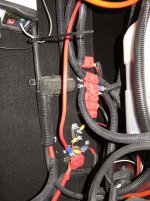oldelmer1
Well-known member
I believe this has been discussed before, but here goes again
After two g for 6 hours today, I checked the voltage on the batteries and
they were down to 11.9v. I've checked my ram 3500 and
I have power on the correct pin for recharging the battery.
I was talking to a friend who toads his car behind his motorhome
And he uses one of these for his road.
http://www.brakebuddy.com/phone/towed-vehicle-battery-charger.html
Do any of you think this would work for charging g the camper batteries
while driving down the road.
After two g for 6 hours today, I checked the voltage on the batteries and
they were down to 11.9v. I've checked my ram 3500 and
I have power on the correct pin for recharging the battery.
I was talking to a friend who toads his car behind his motorhome
And he uses one of these for his road.
http://www.brakebuddy.com/phone/towed-vehicle-battery-charger.html
Do any of you think this would work for charging g the camper batteries
while driving down the road.

